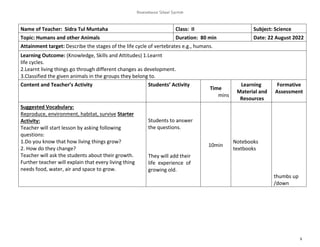
Science Planner Week 1.docx
- 1. Beaconhouse School System 1 Name of Teacher: Sidra Tul Muntaha Class: II Subject: Science Topic: Humans and other Animals Duration: 80 min Date: 22 August 2022 Attainment target: Describe the stages of the life cycle of vertebrates e.g., humans. Learning Outcome: (Knowledge, Skills and Attitudes) 1.Learnt life cycles. 2.Learnt living things go through different changes as development. 3.Classified the given animals in the groups they belong to. Content and Teacher’s Activity Students’ Activity Time mins Learning Material and Resources Formative Assessment Suggested Vocabulary: Reproduce, environment, habitat, survive Starter Activity: Teacher will start lesson by asking following questions: 1.Do you know that how living things grow? 2. How do they change? Teacher will ask the students about their growth. Further teacher will explain that every living thing needs food, water, air and space to grow. Students to answer the questions. They will add their life experience of growing old. 10min Notebooks textbooks thumbs up /down
- 2. Beaconhouse School System 2 INTRODUCTION: Teacher will explain students the life cycles. Teacher will explain the sequence of events of life to interpret different stages. Group activity: Then ask students to make pictures of their fellow’s childhood pictures and then year by year. Students to draw pictures 10min 20 mins White board Rim pages Pencils Colors Oral responses :-) Then, teacher will ask students to present their pictures to their groups and observe that how have they grown up every year. Individual Task: Students will draw different pictures while growing up and they will label the cycle like one year old two years etc. Wrap up: what do you know about the life cycle? what are the stages of development? Discuss the baby pictures and adults you have made. Homework: Write different vocabulary such as development, aging, growing and changing in your notebooks. All stages will be discussed orally. Writing diary: Students to write diary 10min 10 mins 10min 10min Textbooks pictures Thumbs up Thumbs down How will you make the lesson inclusive? Students to write short sentences about the given animal by teachers help Use as many rows in the table as applicable – add rows if necessary
- 3. Beaconhouse School System 3 Lesson Evaluation Strengths Areas for improvement Name of Teacher: Sidra Tul Muntaha Class: II Subject: Science Topic: Humans and other Animals Duration: 80 min Date: 25 August 2022 Attainment target: Describe the stages of the life cycle of invertebrates e.g., butterfly. Learning Outcome: Students will be able to identify the four life stages of a butterfly. 1. Explained life cycle of an insect. 2. written about the life cycles. 3. described stages of life Content and Teacher’s Activity Students’ Activity Time mins Learning Material and Resources Formative Assessment
- 4. Beaconhouse School System 4 Suggested vocabulary: butterfly, chrysalis, and caterpillar. Ice breaking Activity; Teacher will ask students to visit the school garden on an “insect-hunt”. Magnifying glasses will be provided to the students to record their findings. DEVELOPMENT: Write the vocabulary words on the board (butterfly, chrysalis, and caterpillar). Group Activity: “The very hungry caterpillar” Teacher will play a video on multimedia. Explain to the students that they will be chrysalis, larva, Lepidoptera, metamorphosis, pupa, Students to hunt an insect. Student will find insects and take their pictures. 20 min 10min 20min School ground Classroom Garden Magnifying glasses Thumbs up/down Mental, written and oral responses Written
- 5. Beaconhouse School System 5 listening to the story The Very Hungry Caterpillar by Eric Carle. Call on a few students to offer their ideas. Explain to the students that while you are reading, they should listen for the following words: butterfly, chrysalis, eggs, and caterp illar. Have them consider how these words relate to the story and the very hungry caterpillar. Explain that a butterfly is a winged insect. The butterfly starts as an egg and then hatches to be a caterpillar, which looks like a worm that will eventually grow into a butterfly. The caterpillar turns into a chrysalis, which is like a small protective house. Wrap up: . As the students are reading, write the following terms on the board: ● EGG ● LARVA ● PUPA ● ADULT Each student will explain every word. Write diary . Students will write the different insects found around the school. Students will watch the video. Students will write the vocabulary written on the white board. chrysalis, larva, Lepidoptera, metamorphosis, pupa, butterfly, chrysalis, and caterpillar. Individual task: Students to talk about the similarities for different groups of vertebrates. Students to write diary 10 min 10min 10min Multimedia Sticky notes Pencils White board Thumbs up/down Oral How will you make the lesson inclusive?
- 6. Beaconhouse School System 6 Use as many rows in the table as applicable – add rows if necessary Lesson Evaluation